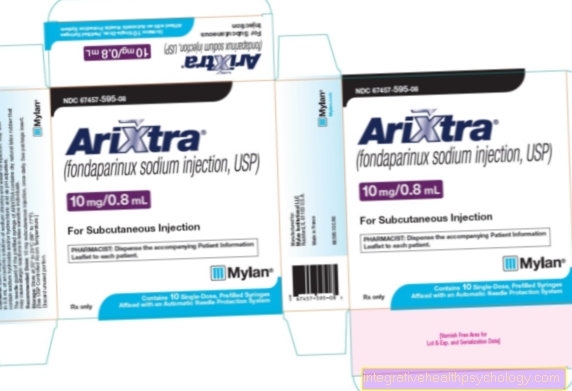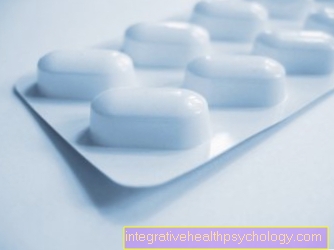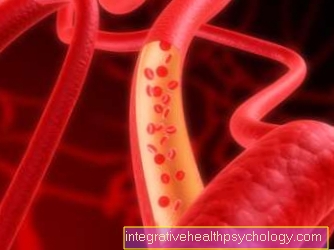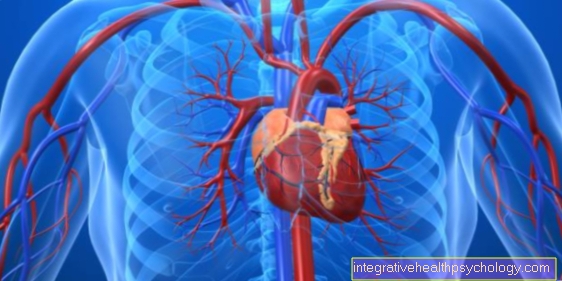Luteinizing hormone
definition
The Luteinizing hormone, LH (translated as "yellow coloring hormone") affects the gonads in humans and fulfills important functions for reproductive capacity (so-called. Fertility). It is indispensable for ovulation in women and for the maturation of sperm in men.
It is a so-called peptide hormone, which consists of protein. It is made in Anterior pituitary gland (the pituitary gland), the stimulus for this is provided by another, higher-level hormone, the Gonadoliberin (GnRH).

Mode of action
The luteinizing hormone regulates the synthesis and secretion of sex hormones in the gonads of men and women. In this respect it is essential for the reproductive ability of both sexes.
In men, the LH affects so-called Leydig cells in the testes and thus promotes the synthesis and release of testosterone.
The LH plays an important role in the female cycle. Cycle day triggers ovulation.
After ovulation, the auxiliary cells of the egg remain in the mucous membrane of the ovary, which are now called the corpus luteum (Corpus luteum) form . For this reason, this hormone is also called the yellow coloring hormone (luteinizing hormone).
The corpus luteum now produces the stimulated by the LH Progesterone. This hormone prepares the lining of the uterus for pregnancy or for an egg cell that can implant itself when fertilized.
If the egg cell is not fertilized, the corpus luteum regresses and the resulting lack of progesterone eventually leads to a menstrual period.
values
In the case of LH, a standard value that applies in principle cannot be specified.
The concentration of the LH in the blood depends on whether it is a woman or a man. In addition, the normal ranges of the LH differ depending on whether it is a girl before puberty, a sexually mature woman or a woman after the menopause.
Different normal values are also valid in different phases within the female cycle. The concentration of the hormone in the blood is given in the unit IU / l (International Units per liter).
In women, the normal value in the first cycle phase (day 1 to approximately day 12-14) is in the range of 1.9-12.5 IU / l.
Shortly before ovulation, during the LH peak (sudden increase in LH that triggers ovulation), the concentration is 8.7-76.3 IU / l. So-called ovulation tests measure this value and thus indicate the fertile days of the woman when she wants to have children.
In the second half of the cycle, the normal range is between 0.5-16.9 IU / l. After menopause, a value of 15.9-54.0 IU / l is normal. In children before puberty, the value can be up to 6 IU / l.
In men, a blood concentration of 1.5-9.3 IU / l is normal.
Basically it can be said that the LH pulsatile, so is poured out in bursts. Therefore, several measurements on the same day can produce different results, as it is not a continuous process. Different laboratories also have different standard values, which should be taken into account when interpreting them.
Read more on the topic: How do I get pregnant?
What can trigger elevated values?
Elevated levels may be normal in women just before ovulation, as this surge in LH triggers ovulation.
Permanently increased concentrations of LH can indicate an underactive ovarian function (so-called. primary ovarian failure). Due to the lack of function of the ovaries, the LH is increased by regulation and tries unsuccessfully to activate the ovaries
Also the clinical picture of polycystic ovaries (Ovaries with many cysts) can trigger a variety of hormonal changes, such as a surge in LH. Infertility, menstrual disorders, acne or excessive body hair are common.
Early menopause can also trigger increased LH levels.
In men, as in women, it can be caused by an underactive testicle (so-called primary testicular failure) lead to an increase in LH levels.
Both men and women can have an overfunction in the LH's place of education, i.e. in the Pituitary gland (Pituitary gland), cause increased values. This can be done, for example, by a Pituitary adenoma, a mostly benign tumor.
What can trigger lowered values?
Decreased LH levels can be triggered by a disturbance in the place where the hormone is produced, the pituitary gland (pituitary gland).
The pituitary gland, more precisely the Anterior pituitary gland, located in the brain, this is where the LH is formed and released. This is stimulated by another hormone from the brain, the gonadoliberin (GnRH), which from the Hypothalamus (a section of the diencephalon) comes from.
An underfunction of the hypothalamus can also cause decreased LH values.
Taking the pill, anorexia or the rare Kallmann syndrome lead to decreased LH values.
In men, it can also occur when taking testosterone (e.g.for medical reasons) negative feedback leads to decreased LH values.
Menopause
During menopause, there are fundamental changes in the woman's sex hormones.
Since the estrogen level alone is not meaningful, LH and that also become Follicle Stimulating Hormone (FSH) certainly. The FSH increases in menopause to up to 30 times the normal value. The LH level increases up to 5 times during menopause.
The value is usually over 15 IU / l during menopause.
If the FSH level is already elevated, but the LH level is still normal, the ovaries still have some residual function.
However, the LH level is subject to strong fluctuations during the menopause, so that multiple checks should always be carried out. After menopause (postmenopausal) the LH level is still increased.
More information on menopause
Place of education
The luteinizing hormone is made in the pituitary gland, the Adenohypophysis (Anterior lobe of pituitary gland) educated.
The synthesis and release of LH is controlled by a hormone from the hypothalamus (a section of the diencephalon) called gonadoliberin (GnRH).
The LH in turn stimulates the production and release of estrogen and progesterone in the ovaries and from testosterone in the testicle. For this reason one speaks of the Hypothalamic-Pituitary-Ovarian Axis (or. Hypothalamic-pituitary-testicular axis).
It is subject to the principle of negative feedback, so that Testosterone, estrogen or progesterone at receptors of the pituitary gland (Pituitary gland) and the hypothalamus (a section of the diencephalon) and stop the release of LH and gonadoliberin. This means that these hormones slow down their own release at increased concentrations, since the amount available is already sufficient. If the concentration is reduced, however, fewer hormones bind to these receptors and more LH and gonadoliberin are released again.
The sufficient concentration of end products (Estrogen, progesterone, testosterone) regulates the release of LH and gonadoliberin at the previous stations and thus ensures normal concentrations in the ideal case.
More information about reproductive hormones
Further information on the topic of reproductive hormones:
- Prolactin
- Oxytocin
The following topics could be of interest to you:
- Pituitary gland
- Endocrine system
- Menopause hormones
- Menopause symptoms
- Hormones in pregnancy
- Lack of estrogen
- Hormones of the posterior pituitary gland





























